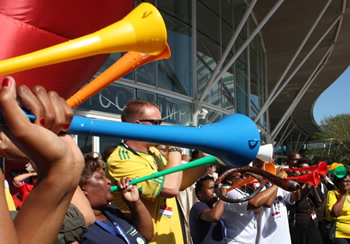Vuvuzelas: What’s the Buzz?
Posted on by
They have been compared to a heard of stampeding elephants, the drone of a thousand bees, or the sound of a goat being dragged to slaughter—and they are the latest craze at the World Cup. The vuvuzela, a plastic, meter-long South African horn sanctioned by FIFA as part of the “signature South African World Cup” has drawn criticism for disrupting the games, interfering with broadcasts, and potentially impairing spectators’ hearing.
A study published in the South African Medical Journal found that the actual sound output created by the vuvuzela reached dangerously high levels, averaging 131 decibels, A-weighted (dBA) at the horn opening and 113 (dBA) at a 2-meter distance from the vuvuzela. Eight of the 10 study participants experienced peak sound pressure levels that exceeded 140 (dB) with a maximum peak level reaching 144 (dB). As a comparison, a jet engine at takeoff measures 130-140 (dB). Additionally, the study found significant changes in participants post-match hearing thresholds and cochlear responsiveness. These results led the researchers to recommend hearing protection for football match spectators.
Fans are lucky to attend a game or two, but what about the players, event staff, stadium workers, broadcasters and referees who are repeatedly exposed to the noise? These levels exceed most national and international standards on permissible exposure limits. NIOSH recommends that noise exposures not exceed 85 (dBA) over an 8-hour time-weighted average (TWA) and 140 (dB) for any period of time. For instance, at the 2-meter distance, a person can’t be exposed to more than 45 seconds per day at the 113 (dBA) level. The noise levels described in the South African study are most likely to be exceeded by 5-10 (dBA) when we consider the thousands of vuvuzelas being blown simultaneously at an actual football/soccer match. Hearing loss and tinnitus (ringing in the ears) are possible and serious consequences of this overexposure, and they can interfere with communication and our quality of life. Some teams are calling for a ban and the executive of the tournament’s local organizing committee warned “that the plastic horns could be banned if fans don’t show more respect in their bugling.” Additionally, the company that provides the broadcasting feed for the World Cup is doubling its audio filters to reduce the noise and disturbance created by the horns (AP 6/16/10). However, vuvuzelas continue to be allowed and they still present a major hearing hazard for spectators, players, and stadium workers alike. Like the South African researchers, we would encourage the use of hearing protection in stadiums that continue to allow vuvuzelas.
The controversy about the use of the noisy vuvuzelas highlights some of the hearing hazards that can be encountered at sporting events and that can contribute to hearing loss or tinnitus. A recent paper from NIOSH looked at noise exposures in stock car racing. The study found that that noise levels on three race tracks exceeded those measured in many hazardous industrial environments. Personal exposure measurements exceeded the NIOSH recommended exposure limit of 85 dBA as an 8-hour TWA in less than a minute for one driver during practice, within several minutes for team members, and less than one hour for spectators during the race. NIOSH also found similarly high levels of noise at monster truck events, concerts and clubs.
Throughout all aspects of our daily lives, we need to better identify dangerous levels of noise and take appropriate actions to reduce and control unwanted exposures. For more information about hearing loss, visit the NIOSH noise and hearing loss prevention topic page.
Mr. Kardous is a research engineer in the NIOSH Division of Applied Research and Technology.
Dr. Morata is a research audiologist in the NIOSH Division of Applied Research and Technology.
References
Swanepoel de W, Hall JW 3rd, Koekemoer D. Vuvuzela sound measurements. S Afr Med J. 2010 Mar 29;100(4):192
Swanepoel D, Hall JW III, Koekemoer D. Vuvuzela – good for your team, bad for your ears. S Afr Med J 2010; 100: 99-100
Kardous CA, Morata TC [2010]. Occupational and Recreational Noise Exposures at Stock Car Racing Circuits: An Exploratory Survey of Three Professional Race Tracks. Noise Control Eng J 58(1):54-61
NIOSH [1998]. Health Hazard Evaluation and Technical Assistance Report: the Crown, U.S. Hot Rod Monster Truck and Motocross Show, Cincinnati, Ohio: U.S. Department of Health and Human Services, Public Health Service, Center for Disease Control, National Institute for Occupational Safety and Health, NIOSH HETA Report No. 98-0093-2717
Posted on by

